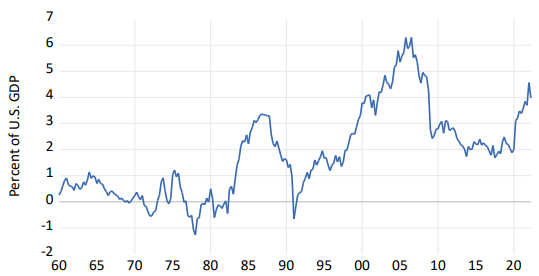| Author Name | Willem THORBECKE (Senior Fellow, RIETI) |
|---|---|
| Research Project | East Asian Production Networks, Trade, Exchange Rates, and Global Imbalances |
| Download / Links |
This Non Technical Summary does not constitute part of the above-captioned Discussion Paper but has been prepared for the purpose of providing a bold outline of the paper, based on findings from the analysis for the paper and focusing primarily on their implications for policy. For details of the analysis, read the captioned Discussion Paper. Views expressed in this Non Technical Summary are solely those of the individual author(s), and do not necessarily represent the views of the Research Institute of Economy, Trade and Industry (RIETI).
The Federal Reserve raised the federal funds rate by 425 basis points between January 2022 and December 2022 to fight inflation. The U.S. is also running a budget deficit of 6.1% of GDP in fiscal year 2022. It ran budget deficits averaging 13.7% of GDP in 2020 and 2021. The Bank for International Settlements real effective exchange rate for the dollar appreciated 18% between January 2021 and October 2022. It is now at its highest level since 1985.
In 1985 the G5 nations (France, West Germany, Japan, the U.S., and the UK) weakened the real effective dollar exchange rate through the Plaza Accord. At that time the combination of anti-inflationary monetary policy and U.S. budget deficits of 5% of GDP caused real interest rates around the world to soar. West German Chancellor Helmut Schmidt observed that real interest rates in the 1980s reached their highest level since the time of Christ. Higher real interest rates in the U.S. compared to its trading partners caused the U.S. real effective exchange rate to appreciate by 40% between 1980 and 1985. U.S. exporting and import-competing firms lost their price competitiveness. The U.S. ran trade and current account deficits reaching 3% of GDP in 1985.
The U.S. steel, textile, agriculture, automobile, and capital goods sectors suffered. The carnage facing American manufacturers jolted Congress into action. In 1985 members of Congress introduced 99 trade bills that were overtly protectionist and 77 that were potentially protectionist.
To deflect protectionist pressures, the G5 countries focused in the 1985 Plaza Accord on the macroeconomic determinants of trade imbalances. The current account balance equals the difference between national saving (private saving minus the budget deficit) and investment. The U.S. reduced its budget deficit to increase national saving, Japan and Germany enacted stimulative policies to reduce national saving, all five countries worked together to reduce the value of the dollar, and all agreed to resist protectionist pressures. The real effective dollar exchange rate depreciated in an orderly manner.
Figure 1 shows that the U.S. current account deficit improved and turned to surplus in 1991. The figure also shows, however, that the current account has been in continual deficit ever since and averaged 3.4% of GDP between 2000 and 2022. It has averaged 4.3% of GDP for the first two quarters of 2022. Many of the changes in the current account deficit are driven by changes in the trade deficit. These deficits harm the U.S. by causing a massive wealth transfer to the rest of the world. They harm Asian countries by stoking protectionist pressures in the U.S. This was evident during the Plaza Accord period.
The results in the paper indicate that the price elasticities for U.S. exports and imports are large enough for a dollar depreciation to improve the U.S. trade balance, so the U.S. could benefit if the dollar depreciated. To further improve the trade balance, the U.S. should reduce its budget deficit.
Excessive real depreciations such as those that Asian economies are experiencing in 2022 may inflict damage. East Asian economies have few natural resources and are dependent on imports of oil, commodities, and food. These are typically priced in U.S. dollars. When Asian currencies depreciate in nominal terms against the dollar, the local currency costs of these imports increase. The U.S. dollar costs of oil, commodities, and food are already elevated because of the Ukraine War. Japan and South Korea have run large trade deficits over the January – September 2022 period. Continued nominal depreciations risk creating a vicious cycle, where depreciations increase the local currency cost of imports and thus the trade deficit and this in turn causes depreciations. Depreciations are also leading to cost-push inflation in Asia at a time when inflation is already high.
Japan judged that the weak yen in October 2022 was harmful and spent 6.35 trillion yen to strengthen the yen; however, these interventions did little to strengthen the yen. In this instance coordinated intervention with the U.S. might have helped Japan to achieve its own goal of strengthening the yen. Korea and Taiwan were also concerned about their own weak currencies at the same time. So Asian countries may want to see their currencies appreciate. It could be that East Asian currencies will appreciate and the dollar will depreciate. If they do not, or if they do and then the U.S. dollar again returns to stratospheric levels against Asian currencies, each country should consider whether coordinated exchange rate intervention might be in their interest.


